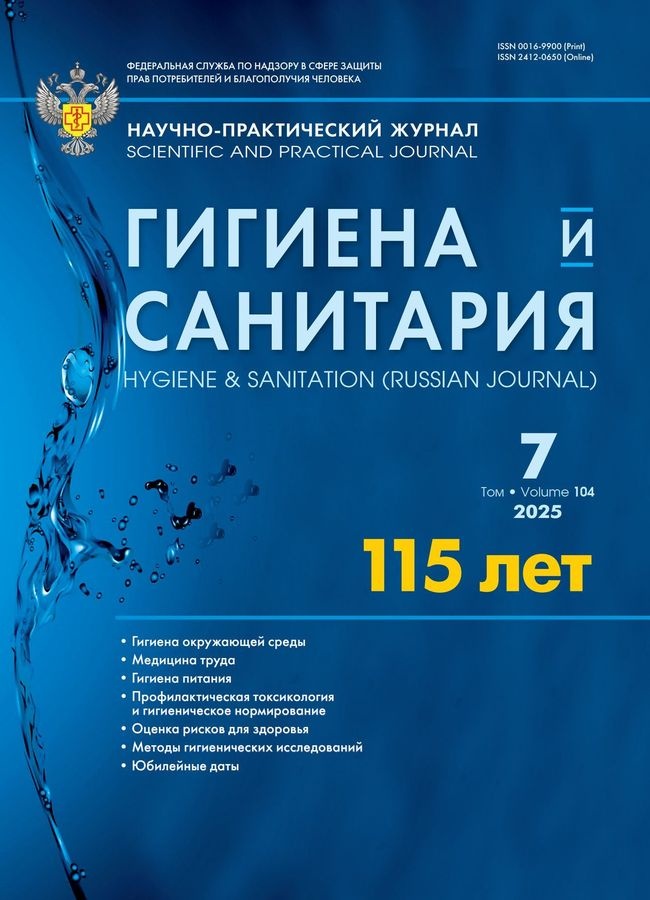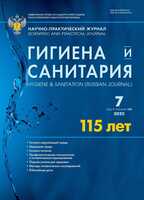Hygiene and Sanitation
Scientific and practical journal
Editor-in-chief
- Valery Nikolaevich Rakitsky
Academician of the Russian Academy of Sciences, Honored Scientist of the Russian Federation, Doctor of Medical Sciences, Professor
Federal Scientific Center of Hygiene named after F.F. Erisman of Rospotrebnadzor, Institute of Hygiene, Pesticide Toxicology and Chemical Safety (Mytishchi) ORCID iD: 0000-0002-9959-6507
Publisher
- Federal Scientific Center of Hygiene named after F.F. Erisman of Rospotrebnadzor (Mytishchi)
Founders
- Federal Service for Surveillance on Consumer Rights Protection and Human Wellbeing
About the journal
Indexation
- Russian Science Citation Index (RSCI)
- Google Scholar
- Crossref
- Ulrich's Periodicals Diretory
- Scopus
Journal's homepage
About journal
Year of foundation: 1910
A leading general-purpose hygienic journal. Publishes articles on all sections of hygienic science and sanitary practice. The main attention is paid to the issues of environmental and populated areas hygiene, human ecology, hygiene of children and adolescents and radiation hygiene, occupational hygiene, food hygiene and social hygiene, health risk assessment. Original articles and literature reviews are accepted.
Target audience: sanitary doctors and hygienists, organizers of sanitary affairs, employees of hygiene and epidemiology centers, Rospotrebnadzor departments, employees of research hygiene institutes and the faculty of hygiene departments of medical institutes.
The journal "Hygiene and Sanitation" is included in the List of peer-reviewed scientific publications in which the main scientific results of dissertations for the degree of candidate of sciences, for the degree of doctor of sciences of the Higher Attestation Commission (HAC) of the Ministry of Science and Higher Education of the Russian Federation in the following specialties must be published:
- 3.2.1. Hygiene (medical)
- 3.2.1. Hygiene (biological)
- 3.2.4. Occupational Medicine (medical)
- 3.2.4. Occupational Medicine (biological)
- 3.3.4. Toxicology (medical)
- 3.3.4. Toxicology (biological)
- 1.5.11. Microbiology (medical sciences)
- 1.5.15. Ecology
The journal "Hygiene and Sanitation" is also included in the list of domestic publications that are included in international abstract databases and citation systems.
Main sections of the journal
- Environmental hygiene
- Occupational medicine
- Children's and adolescents' hygiene
- Food hygiene
- Health risk assessment
- Preventive toxicology and hygienic regulation
- Social and hygienic monitoring
- Hygienic research methods
Frequency
- 12 times a year
Edição corrente
Volume 104, Nº 7 (2025)
- Ano: 2025
- ##issue.datePublished##: 15.07.2025
- Artigos: 19
- URL: https://ruspoj.com/0016-9900/issue/view/13976
- DOI: https://doi.org/10.47470/0016-9900-2025-104-7
Edição completa
ENVIRONMENTAL HYGIENE
Diseases of the circulatory system and life expectancy of men in an industrial region
Resumo
 818-825
818-825


Effect of polymorphisms of the GSTM1 and GSTT1 genes in combination with a high anthropogenic load on the development of the great obstetrical syndromes
Resumo
 826-831
826-831


Assessment of the role of heavy metals in the etiology of arterial hypertension in the population
Resumo
 832-838
832-838


OCCUPATIONAL HEALTH
Emotional component of the quality of life in miners with dust lung pathology
Resumo
 839-843
839-843


Genetic polymorphisms and risks for developing of occupational pathology (literature review)
Resumo
 844-850
844-850


Interrelationship between the rs1800469 polymorphic locus of the TGF-β1 gene and a decrease in global longitudinal deformation of the left ventricular myocardium in coal mining workers
Resumo
 851-859
851-859


Assessment of risk fors for the development of ischemic heart disease in workers of vibration-hazardous occupations
Resumo
 860-866
860-866


Risk factors for the development of pre-stage heart failure in workers of the main occupations in the coal mining industry
Resumo
 867-873
867-873


The search for genetic polymorphisms associated with vibration disease
Resumo
 874-878
874-878


Working conditions and health status in workers in the production of mineral fertilizers
Resumo
 879-886
879-886


Various parameters of functional states in workers at a logging enterprise in conditions of the Far North at different stages of the shift period
Resumo
 887-894
887-894


Features of emotional burnout in health care professionals and manifestations of character accentuation
Resumo
 895-900
895-900


FOOD HYGIENE
Features of nutrition the in first-graders of various generations on weekends
Resumo
 901-907
901-907


Food waste in schools from various countries: A systematic review
Resumo
 908-913
908-913


Improving the assessment of compliance of biologically active food additives with established quality and safety requirements (literature review)
Resumo
 914-918
914-918


PREVENTIVE TOXICOLOGY AND HYGIENIC STANDARTIZATION
Evaluation of the toxic effect of 2-diethylaminoethyl chloride hydrochloride
Resumo
 919-924
919-924


HEALTH RISK ASSESSMENT
Assessment of the risk caused by soil contamination with heavy metals and arsenic for the population at the city with glass production
Resumo
 925-929
925-929


METHODS OF HYGIENIC AND EXPERIMENTAL INVESTIGATIONS
Validation of the methodology for measuring mass concentrations of chemical elements in blood by mass spectrometry method with inductively coupled plasma
Resumo
 930-935
930-935


ANNIVERSARY DATES
To the 70th anniversary of Omor T. Kasymov
Resumo
 936-936
936-936











